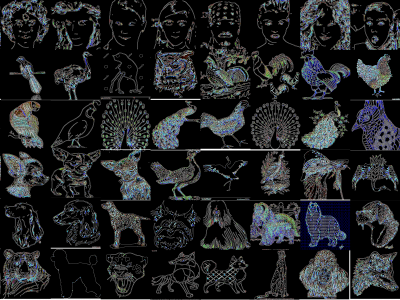Datasets
Standard Dataset
Geometrons - Ghost Symbols - Buried Information
- Citation Author(s):
- Submitted by:
- Abdourrahmane Atto
- Last updated:
- Wed, 09/25/2024 - 15:52
- DOI:
- 10.21227/5112-ez52
- Data Format:
- License:
 179 Views
179 Views- Categories:
- Keywords:
Abstract
The dataset provides a collection of image-based classification and regression problems for artificial intelligence, under extreme visual attention constraints. Spatial shapes with simple geometries and called geometrons are embedded in an intense visual texture stream, with the aim of investigating the limits of artificial visual attention to capture known or unknown, but ghost or buried shapes.
Geometron classification problems:
Problem 1: recognizing the elementary shapes called "geometrons (binary)" (143 classes). Problem 1 is a classification issue that can be decomposed in several sub-problems since 3 sub-categories of binary geometrons are provided: mathematical alphabet (76 classes), standard shapes (49 classes) and irregular polygonal shapes (18 classes).
Problem 2: encrypted geometrons, super-visual attention. Same as Problem 1, but the geometrons are now "ghost information in a world of textures". Human eyes can sometimes see the ghosts, but at the cost of a high level of visual attention for the recognition of some features that allow for the identification of the class associated with a ghost geometron, in such a complex environment.
Problem 3: encrypted geometrons, ultra-visual attention. Same as Problem 2, but only "machines" can (?) now see the ghost or buried geometrons.
Geometron decoding problems (Image to Image)
Problem 4: Consider an encrypted geometron in the "super-visual attention" folder and find a model that can decode the content of any pixel. In this problem, the encrypted geometron is considered as an input, and its corresponding interference-free geometron located in the “Geometrons” folder is the desirable output of machine/deep learning model.
Problem 5: Same as Problem 4, but by using the "ultra-visual attention" folder for inputs and "Geometrons" folder for outputs.
Remarks:
1/ if we consider the singles, pairs and triplets of sub-folder fusion possibilities and by mixing super and ultra attention, studying attention per shape, etc., then we have hundreds of AI problems associated with the dataset.
2/ if your favourite machine is unable to learn and you wish to challenge it with better resolved images, ...., you can send a REQUEST to IEEE dataport to identify the possibilities of making high-resolution data available via this platform (several TB, 2048x2048 images). Textures are composites of elliptical multi-fractional anisotropic Brownian fields, defined in paper "Toward Generalized Artificial Intelligence by Assessment Aggregation With Applications to Standard and Extreme Classifications", https://doi.org/10.1109/TNNLS.2023.3297079
Dataset Files
- Geometrons (Binary) - Part 1 : Alphabet Maths GeometronsBinary_-_AlphabetMaths.zip (222.82 MB)
- Geometrons (Binary) - Part 2 : Standard Shapes GeometronsBinary_-_StandardShapes.zip (245.23 MB)
- Geometrons (Binary) - Part 3 : Irregular Polygons GeometronsBinary_-_SubsetOfIrregularPolygons.zip (112.78 MB)
- Encrypted Geometrons Level 1 / Super Visual Attention - Part 1 : Alphabet Maths GeometronsEncrypted_SuperVisualAttention_-_AlphabetMaths.zip (44.35 GB)
- Encrypted Geometrons Level 1 / Super Visual Attention - Part 2 : Standard Shapes GeometronsEncrypted_SuperVisualAttention_-_StandardShapes.zip (28.50 GB)
- Encrypted Geometrons Level 1 / Super Visual Attention - Part 3 : Irregular Polygons GeometronsEncrypted_SuperVisualAttention_-_SubsetOfIrregularPolygons.zip (10.60 GB)
- Encrypted Geometrons Level 2 / Ultra Visual Attention - Part 1 : Alphabet Maths GeometronsEncrypted_UltraVisualAttention_-_AlphabetMaths.zip (46.89 GB)
- Encrypted Geometrons Level 2 / Ultra Visual Attention - Part 2 : Standard Shapes GeometronsEncrypted_UltraVisualAttention_-_StandardShapes.zip (30.08 GB)
- Encrypted Geometrons Level 2 / Ultra Visual Attention - Part 3 : Irregular Polygons GeometronsEncrypted_UltraVisualAttention_-_SubsetOfIrregularPolygons.zip (11.16 GB)
Documentation
| Attachment | Size |
|---|---|
| 378.1 KB |









